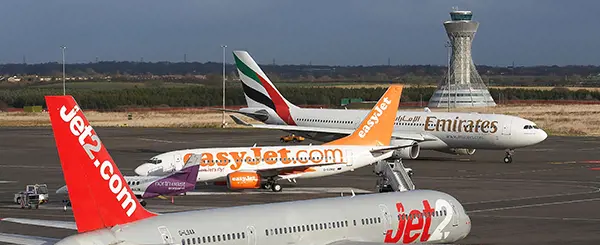Since Lichfields’ first
blog, momentum behind the Aviation Powerhouse has grown. Manchester displaced Stockholm as it entered Europe’s top 20 airports with 25.9 million passengers for the first time
[1]. The Department for Transport (DfT) published a number of aviation consultations, including the draft Airports National Policy Statement (NPS), the Government has opened consultation on its Northern Powerhouse Strategy
[2], whilst Transport for the North
[3] and George Osborne’s Northern Powerhouse Partnership
[4] released new think pieces on the Northern Powerhouse. Manchester has also hosted the second Northern Powerhouse conference.
DfT’s consultations have focused on the need for runway capacity in the South East and the proposed Heathrow Airport expansion. This places the onus on Heathrow to demonstrate in any future development consent order application how a new runway will support regional connectivity across the UK. The draft NPS and various ministerial statements have made clear the importance of providing better regional access to Heathrow, once Runway 3 is constructed.
Direct links between Heathrow and the Northern Powerhouse’s airports will be essential to take advantage of the wider range of destinations offered by Heathrow than are currently served by the existing airports in the north. But this benefit is dependent on providing them with access to Heathrow to enable interlining. The Aviation Powerhouse has untapped capacity and is well-placed to capitalise on greater connectivity to Heathrow. But it is important that once finalised, the NPS does not overlook the Aviation Powerhouse’s recent impressive growth and the role it can play in providing capacity for increased global connectivity. As Charlie Cornish of Manchester Airports Group has pointed out, the Government needs to ask “
how we are going to make best use of the runway capacity we have in this country, by improving access to airports with capacity which are now growing significantly”
[5].
Transport for the North and the Northern Powerhouse Partnership have been busy promoting the Northern Powerhouse and suggesting ways to strengthen the Aviation Powerhouse. This includes a number of pragmatic steps that DfT should consider.
Central to Transport for the North’s Independent International Connectivity Commission Report is that connectivity needs to be a priority for the Northern Powerhouse to harness the economic benefits from internationalisation. Relying on South East airports for international business travel and freight offers greater international connectivity but increases costs and reduces competitiveness for businesses in the Northern Powerhouse.
Transport for the North offers a solution: secure more direct long haul passenger services in the Aviation Powerhouse, with belly hold capacity for freight. Businesses in the Northern Powerhouse would benefit immediately. It would improve their cost competitiveness and give them greater access to new markets. Transport for the North reasons that improving business-related aviation will give the biggest boost to the Northern Powerhouse’s productivity.
Akin to our suggestion that the Aviation Powerhouse should be treated as a cluster of airports, Transport for the North suggests that establishing new routes should be coordinated across the Northern Powerhouse. Whilst the aviation market is generally responsive to demand, Transport for the North argues that coordinating new route development should improve the Northern Powerhouse’s competitiveness. For example, creating new complimentary short haul routes from Liverpool and Newcastle, and promoting the growth of long haul routes from Manchester will give Northern Powerhouse businesses much greater access to global markets.
Improving connectivity to and from airports within the Aviation Powerhouse has also been promoted by Transport for the North. They recommend a series of ‘surface access’ schemes, such as improving the link road between Newcastle airport and the A1.
By improving accessibility to airports, Transport for the North argues that the proposed schemes will generate more demand from businesses in the Northern Powerhouse and extend airport catchment areas (benefiting a larger area). In turn, this will improve the competitiveness of the Aviation Powerhouse and grow demand for increased frequencies and new routes.
Given the potential for an additional 60 million air passengers a year
[6], the Aviation Powerhouse has significant untapped capacity. This could give a big stimulus to the Northern Powerhouse and UK economies. The currently unused capacity offers great potential in the long term to benefit from Heathrow’s expansion, but it also presents short term opportunities to improve global connectivity to the Northern Powerhouse. The Northern Powerhouse needs to engage with the Government’s aviation consultations to ensure that it maximises the benefits from Heathrow’s proposed expansion. Recent efforts by Transport for the North and the Northern Powerhouse Partnership to promote the strength and potential of the Aviation Powerhouse have been well-received by the business community – capturing the opportunities will reap rewards.
The Government recently announced Growth Deal 3 funding of c. £556 million for Northern Powerhouse Local Enterprise Partnerships
[7], which could help improve connectivity to Aviation Powerhouse airports. Perhaps DfT could look at building on this existing commitment and play a more active role in supporting the Aviation Powerhouse in using its untapped capacity?
[1] http://www.travelweekly.co.uk/articles/272735/mag-calls-for-manchester-and-stansted-to-form-part-of-aviation-strategy
[2] https://northernpowerhouse.gov.uk/2017/02/northern-powerhouse-stakeholder-engagement-launched/
[3] TfN (February 2017) Independent International Connectivity Commission Report
[4] NPP (January 2017) First Report
[5] http://www.travelweekly.co.uk/articles/272735/mag-calls-for-manchester-and-stansted-to-form-part-of-aviation-strategy
[6] TfN (February 2017) Independent International Connectivity Commission Report
[7] DBEIS (January 2017) Northern Powerhouse: Growth Deals
Image credit: VIEW Pictures Ltd / Alamy



